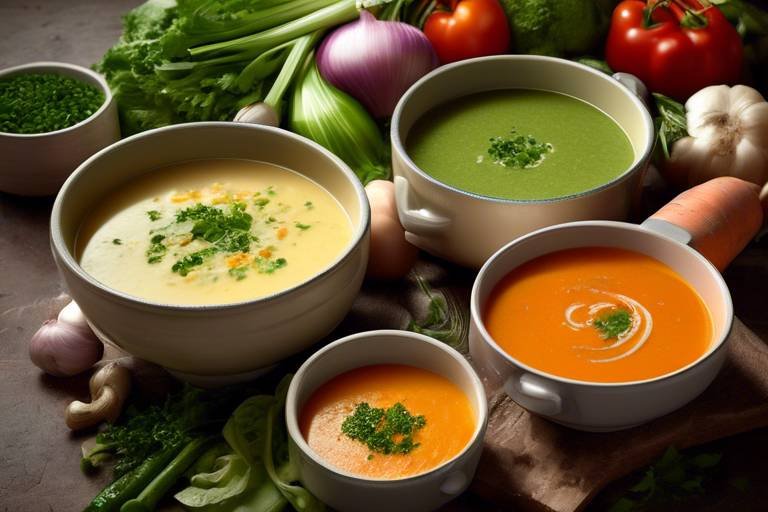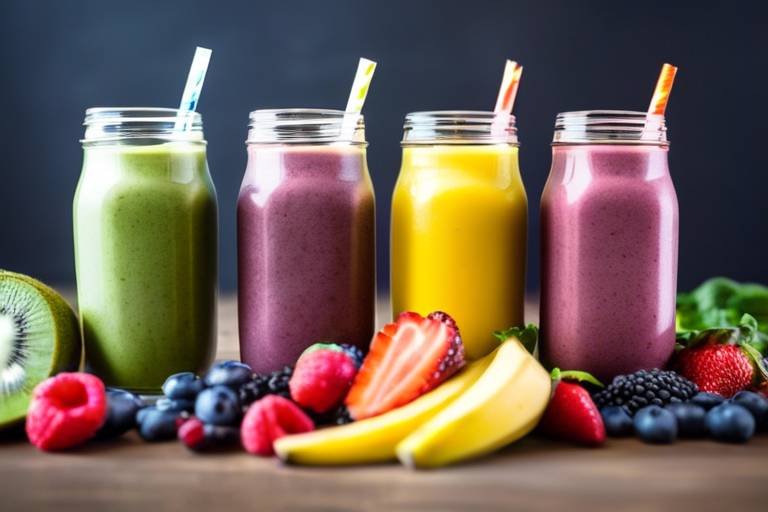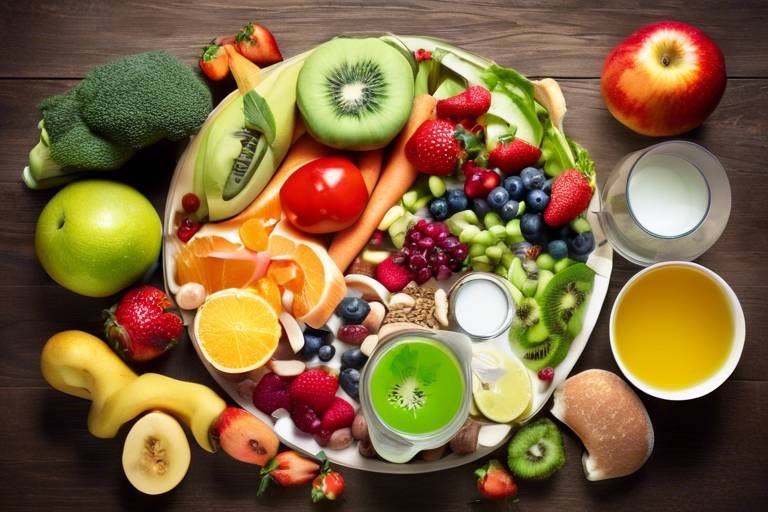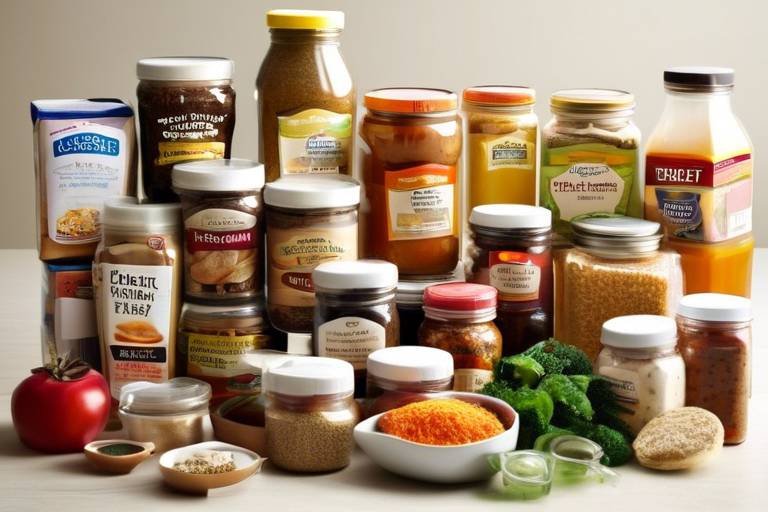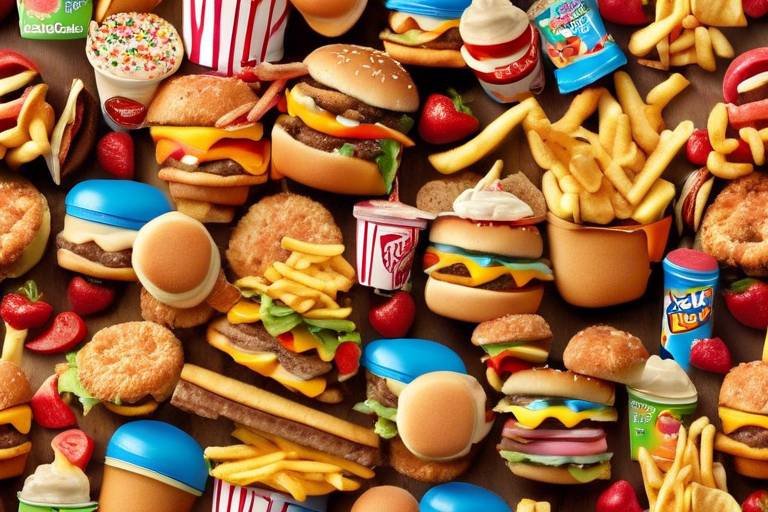A Beginner's Guide to Meal Prepping for Your Family
Welcome to the world of meal prepping! This guide is designed to introduce you to the art of planning and preparing meals ahead of time, making your life easier and your family meals healthier. Imagine coming home after a long day, and instead of scrambling to figure out what to cook, you simply pull out a delicious, pre-prepared meal from the fridge. Sounds fantastic, right? Meal prepping is not just a trend; it’s a lifestyle change that can help busy families save time, reduce stress, and eat healthier together.
So, what exactly is meal prepping? At its core, meal prepping involves preparing meals in advance—whether that's cooking full meals, chopping vegetables, or even just portioning out snacks. The beauty of meal prepping is that it can be tailored to fit any family’s schedule and dietary needs. Whether you’re a busy parent juggling work and kids, or someone just looking to eat healthier, meal prepping can be a game-changer.
But why should you consider meal prepping? The benefits are numerous and can significantly enhance your family's lifestyle. For starters, it saves time during the week, allowing you to spend more quality moments with your loved ones. It also helps reduce food waste, as you’re more likely to use what you buy when you have a plan in place. Plus, it promotes healthier eating habits by keeping you away from those last-minute takeout temptations. In this guide, we’ll explore the various aspects of meal prepping, from essential tips and strategies to tools that can help streamline the process.
Are you ready to dive in? Let's explore the wonders of meal prepping and how it can transform your family's mealtime experience into something enjoyable and stress-free!
Meal prepping is more than just cooking; it’s a systematic approach to managing your meals. By dedicating a few hours each week to plan and prepare, you can create a stress-free environment for your family during mealtime. Think of it as setting up a well-oiled machine—everything is organized, and you know exactly what’s coming next. This not only simplifies your cooking process but also encourages your family to try new dishes and flavors.
One of the biggest advantages of meal prepping is that it can help you avoid the dreaded “What’s for dinner?” question that often leads to unhealthy choices. By having meals ready to go, you can make healthier decisions and ensure that your family is eating nutritious foods. Plus, with a little creativity, meal prep can be fun! You can experiment with different cuisines and flavors, making mealtime an adventure rather than a chore.
Meal prepping offers a wealth of benefits that can positively impact your family's lifestyle. Here are some of the key advantages:
- Time-Saving: By preparing meals in advance, you can significantly cut down on the time spent cooking during the week.
- Reduced Food Waste: Planning your meals helps you use ingredients more efficiently, minimizing waste.
- Healthier Eating Habits: With meals prepped, you're less likely to reach for unhealthy snacks or fast food.
- Cost-Effective: Buying in bulk and planning meals can help you save money on groceries.
These benefits can lead to a happier, healthier family life. Imagine sitting down to a nutritious meal every evening, knowing that you’ve made a conscious effort to care for your family’s health and well-being.
Implementing effective time-saving strategies can significantly enhance your meal prepping experience. Here are some techniques to streamline your cooking process:
- Plan Ahead: Spend a few minutes each week planning your meals. This helps you stay organized and ensures you have everything you need.
- Use a Grocery List: Stick to your list to avoid impulse buys and ensure you have all necessary ingredients.
- Cook in Batches: Prepare large quantities of staple foods like grains or proteins that can be used throughout the week.
By adopting these strategies, you’ll find that meal prepping becomes less of a chore and more of a rewarding experience.
Batch cooking is a fantastic way to ensure you have ready-to-eat meals throughout the week. It involves preparing large quantities of food at once, which can then be portioned out for later use. For instance, you might cook a big pot of chili or roast several chicken breasts. Once cooked, divide them into containers for easy access. This technique not only saves time but also allows for variety in your meals throughout the week.
Transforming leftovers into new meals is a great way to minimize waste and keep things interesting. Instead of simply reheating last night’s dinner, consider how you can repurpose those ingredients. For example, leftover roasted vegetables can be tossed into a salad, or cooked chicken can be transformed into tacos. The possibilities are endless, and it’s a fun way to get creative in the kitchen!
Having the right tools can make meal prepping easier and more enjoyable. Here are some essential kitchen gadgets and containers that will help you organize and store your meals effectively:
- Meal Prep Containers: Invest in a set of durable, stackable containers for easy storage.
- Sharp Knives: A good set of knives will make chopping and prepping a breeze.
- Slow Cooker or Instant Pot: These appliances can save time and effort when cooking meals.
With these tools at your disposal, you’ll be well-equipped to tackle your meal prepping journey.
A well-thought-out meal plan is the foundation of successful meal prepping. Start by considering your family's preferences and dietary needs. A balanced meal plan should include a variety of proteins, grains, and vegetables to keep things interesting. Use a calendar or a meal planning app to outline your meals for the week, making adjustments as necessary to accommodate everyone's tastes.
Involving your family in meal planning can enhance their interest in trying new foods. Ask each family member to suggest a meal they’d like to have during the week. This not only makes everyone feel included but also ensures that there’s something for everyone to enjoy. You might even discover new favorites along the way!
Understanding and accommodating dietary restrictions is crucial for family meal prepping. Whether it's allergies, intolerances, or specific dietary choices, it's important to adapt meals to meet various needs. Look for alternatives that are just as delicious, like using quinoa instead of rice or dairy-free cheese for those who are lactose intolerant. With a little creativity, you can create meals that everyone will love while still being mindful of their dietary requirements.
Q: How do I start meal prepping?
A: Begin by planning your meals for the week, creating a grocery list, and setting aside a few hours to cook and portion out your meals.
Q: How long can I store meal-prepped food?
A: Most meal-prepped foods can be stored in the fridge for up to four days. For longer storage, consider freezing meals.
Q: Can I meal prep for just one person?
A: Absolutely! Meal prepping is flexible and can be tailored to fit any number of people, including just yourself.
Q: What are some easy meals to start with?
A: Try simple dishes like stir-fries, casseroles, or soups, which can be easily batch-cooked and stored.

Understanding Meal Prepping
Meal prepping is more than just a trendy kitchen hack; it’s a game changer for busy families looking to streamline their weeknight dinners and make healthier choices. Imagine walking into your kitchen on a Tuesday evening, and instead of the usual chaos, you find pre-cooked meals ready to go. Sounds like a dream, right? Well, that’s the magic of meal prepping!
At its core, meal prepping involves planning and preparing meals in advance. This can mean cooking entire dishes ahead of time or simply chopping vegetables and marinating proteins to save time during the week. The beauty of meal prepping lies in its flexibility; you can tailor it to fit your family’s unique needs and preferences. Whether you have picky eaters, dietary restrictions, or just a busy schedule, meal prepping can simplify your life.
Now, let’s dive into the many advantages of meal prepping. First off, it saves you a significant amount of time during the week. Instead of spending precious hours every evening deciding what to cook and then preparing it from scratch, you can simply heat up a delicious meal that’s already ready. This not only cuts down on cooking time but also reduces the stress of figuring out what’s for dinner on those hectic days.
Additionally, meal prepping helps to minimize food waste. When you plan your meals ahead of time, you’re less likely to buy ingredients that end up sitting in the fridge and spoiling. You can create a shopping list based on your meal plan, ensuring that you only purchase what you need. This not only saves money but also contributes to a more sustainable lifestyle.
Meal prepping also encourages healthier eating habits. When you have nutritious meals ready to go, you’re less likely to reach for unhealthy snacks or fast food. You can control portion sizes and ingredients, making it easier to stick to dietary goals. Plus, involving your family in the meal prepping process can make them more excited about eating healthy. It’s a win-win situation!
In summary, understanding meal prepping is the first step toward transforming your family’s eating habits and making your life easier. By planning and preparing meals in advance, you can save time, reduce waste, and promote healthier eating. So, why not give it a try? Your future self will thank you!

Benefits of Meal Prepping
When it comes to feeding a family, the chaos of daily life can often lead to unhealthy eating habits and wasted food. That's where meal prepping comes in, transforming the way you approach family meals. By dedicating a bit of time upfront to plan and prepare, you can unlock a treasure trove of benefits that not only streamline your week but also promote healthier eating choices for everyone at the table.
First and foremost, one of the most significant advantages of meal prepping is time savings. Imagine this: instead of scrambling to throw together dinner after a long day at work or school, you can simply pull a pre-prepared meal from the fridge. This not only reduces the stress of last-minute cooking but also allows you to spend more quality time with your loved ones. Plus, the time you save can be redirected towards hobbies, exercise, or even just relaxing!
Another fantastic benefit is the considerable reduction in food waste. When you plan your meals, you are less likely to buy ingredients that you won't use. This means fewer trips to the grocery store and less food ending up in the trash. According to recent studies, families can reduce food waste by up to 30%! This is not just good for your wallet; it’s also a win for the environment.
Meal prepping also encourages healthier eating habits. By preparing your meals in advance, you have more control over the ingredients you use, allowing you to create nutritious dishes that cater to your family's dietary needs. This is especially important if you have picky eaters or family members with specific health concerns. When healthy meals are readily available, you're less likely to reach for unhealthy convenience foods, which can be a lifesaver for busy families.
Moreover, meal prepping can be a great way to save money. By planning your meals around what’s on sale at the grocery store or what you already have at home, you can make smarter purchasing decisions. This not only helps you stick to your budget but also encourages you to try new recipes and ingredients, keeping mealtime exciting and varied.
In addition to these benefits, meal prepping fosters a sense of family togetherness. Involving your family in the planning and preparation process can turn cooking into a fun and collaborative activity. Whether it’s having the kids help chop vegetables or discussing what meals to prepare for the week, this involvement can enhance their interest in food and cooking. Plus, it creates lasting memories and teaches valuable life skills.
To summarize, the benefits of meal prepping are both vast and impactful. From saving time and reducing waste to promoting healthier eating habits and saving money, meal prepping can truly transform your family's dining experience. So why not give it a try? You might just find that it’s the key to a more organized, healthier, and happier family life!
- What is meal prepping? Meal prepping is the process of planning and preparing meals in advance to save time and reduce stress during the week.
- How can meal prepping save me money? By planning meals around sales and using ingredients you already have, you can make smarter purchases and reduce food waste.
- Can meal prepping help with picky eaters? Yes! Involving family members in the meal planning process can help cater to their preferences and encourage them to try new foods.
- How do I start meal prepping? Begin by creating a meal plan, shopping for ingredients, and setting aside time to cook and store meals for the week.

Time-Saving Strategies
When it comes to meal prepping, time is of the essence! Imagine being able to whip up a week’s worth of meals in just a few hours. Sounds like a dream, right? Well, with effective time-saving strategies, this can be your reality. The key is to plan ahead and use your time wisely. One of the best ways to get started is by organizing your cooking space. A clutter-free kitchen can make a world of difference. Gather all your ingredients and tools before you start cooking; this will save you from running back and forth to the pantry or fridge.
Another fantastic strategy is to choose recipes that share ingredients. For example, if you’re making a stir-fry, consider using the same vegetables in a salad or a soup. This not only minimizes prep time but also reduces food waste. Speaking of waste, let’s not forget about the power of batch cooking. Preparing larger portions of a meal means you can enjoy it multiple times throughout the week. You could cook a big pot of chili on Sunday and use it for dinner, lunch, or even a quick snack throughout the week!
Additionally, consider investing in some time-saving kitchen gadgets. A slow cooker or an Instant Pot can be a game changer. These appliances allow you to set it and forget it, giving you more freedom to tackle other tasks while your meals cook. And don’t underestimate the power of freezing meals. If you have a busy week ahead, prepare double portions of your favorite dishes and freeze them for later. This way, you’ll always have something healthy and delicious on hand, ready to heat and eat!
To give you a clearer picture, here’s a quick table summarizing some essential time-saving strategies:
| Strategy | Description |
|---|---|
| Organize Your Space | Gather all ingredients and tools before cooking to save time. |
| Share Ingredients | Choose recipes that use similar ingredients to minimize prep time. |
| Batch Cooking | Cook larger portions to have meals ready throughout the week. |
| Use Kitchen Gadgets | Invest in slow cookers or Instant Pots for easy meal preparation. |
| Freeze Meals | Prepare extra portions and freeze them for busy days. |
Finally, don’t forget to schedule your meal prep sessions. Treat them like any other important appointment. Set aside a couple of hours each week to focus on preparing meals. This not only helps you stay organized but also creates a routine that your family can rely on. With these time-saving strategies in place, you’ll find that meal prepping becomes less of a chore and more of an enjoyable family activity!
Q: How often should I meal prep?
A: It depends on your schedule! Many people find that prepping once a week works best, but you can also prep for a few days at a time if that suits your family better.
Q: Can I meal prep for special diets?
A: Absolutely! Meal prepping can be easily adapted to fit various dietary needs, such as vegetarian, vegan, gluten-free, or low-carb diets.
Q: What if my family doesn't like leftovers?
A: Get creative! You can transform leftovers into entirely new meals, like turning roasted veggies into a frittata or chili into a taco night!

Batch Cooking Techniques
Batch cooking is a fantastic way to save time and ensure you always have healthy meals ready to go. Imagine this: instead of scrambling to put together dinner every night, you open your fridge and find prepped meals just waiting for you. It’s like having a personal chef at your beck and call! To get started with batch cooking, you’ll want to dedicate a few hours on a weekend or any day that works for you. This isn’t just about cooking; it’s about creating a strategy that makes your week smoother.
First, choose a few recipes that your family loves and that can be easily scaled up. Think about meals that freeze well, such as soups, stews, casseroles, and even cooked grains. For instance, you can prepare a big pot of chili or a tray of lasagna, which can be portioned out for the week ahead. The key is to focus on dishes that not only taste great but also hold up well when reheated. Here’s a quick tip: always double the recipe! If a recipe calls for four servings, make eight. This way, you’ll have leftovers to stash in the freezer for those busy nights when cooking feels like climbing Mount Everest.
When it comes to batch cooking, organization is your best friend. Start by gathering all your ingredients and tools before you begin. This could include pots, pans, measuring cups, and containers for storing your meals. Having everything at hand will save you from the chaos of searching for that elusive spatula in the middle of cooking. Once everything is prepped, set a timer for each dish you’re making. This will help you stay on track and avoid burning anything while you're multitasking.
After cooking, allow your meals to cool before storing them. This is crucial because placing hot food directly into the fridge can raise the temperature inside, potentially leading to food safety issues. Use airtight containers to store your meals, as they help keep food fresh and prevent freezer burn. Label each container with the name of the dish and the date it was made. This simple step will save you from the dreaded mystery meal dilemma when you’re rummaging through the freezer later.
To make the most of your batch cooking, consider using a meal prep schedule. For example, you might decide that Sundays are for cooking and Wednesdays are for reheating. This routine not only ensures you have meals ready but also helps you plan your grocery shopping effectively. By knowing what you’ll be cooking, you can buy ingredients in bulk, reducing waste and saving money.
Finally, don’t shy away from experimenting! Batch cooking doesn’t have to be boring. Try different flavor profiles, cuisines, or even cooking methods. One week you might batch cook a hearty Moroccan stew, and the next, you could whip up some spicy Thai curry. The world is your oyster, and the more variety you introduce, the less likely you are to fall into a meal prep rut.
In summary, batch cooking is about efficiency and creativity. It allows you to spend less time in the kitchen during the week while still enjoying delicious homemade meals. So roll up your sleeves, gather your family, and turn cooking into a fun and collaborative event. You’ll not only save time but also create lasting memories around the dinner table.

Using Leftovers Wisely
Leftovers are often seen as a burden, but they can be your best friend in the kitchen! Instead of letting those extra portions languish in the fridge, why not get creative and transform them into something entirely new? Think of leftovers as a blank canvas; with a little imagination, you can whip up a masterpiece that your family will love. For instance, that roasted chicken from last night can easily become a hearty chicken salad or a comforting soup. Not only does this method save time, but it also minimizes food waste, which is a win-win for your wallet and the environment!
One effective strategy is to plan for leftovers from the very beginning. When you cook meals, intentionally make extra portions, and then envision how these can be repurposed. For example, if you're making a stir-fry, consider doubling the recipe so you can enjoy it again later in the week as a filling wrap or a topping for a baked potato. This not only keeps things exciting but also ensures that you have a variety of meals to choose from without the hassle of cooking from scratch every day.
Here are some innovative ideas to make the most of your leftovers:
- Mix and Match: Combine leftover proteins, grains, and veggies for a quick stir-fry or grain bowl.
- Soup It Up: Throw leftover meats and veggies into a pot with broth for a delicious soup.
- Wrap It Up: Use leftover meats or veggies in wraps or sandwiches for a quick lunch.
- Frittatas and Omelets: Toss leftover veggies into eggs for a quick breakfast or brunch option.
Also, consider creating a "leftover night" once a week where the family can enjoy a buffet-style dinner featuring all the remnants from the week. This not only makes for a fun and interactive meal but also encourages everyone to get involved in the process of using up what’s in the fridge. You might be surprised at how much your family enjoys this creative approach to dinner!
Remember, the key to using leftovers wisely is to keep things fresh and exciting. With a little planning and creativity, you can turn yesterday's meals into today's culinary delights. So next time you find yourself with extra food, don’t shy away—embrace it! Your taste buds and your family will thank you.
Q: How long can I keep leftovers in the fridge?
A: Generally, leftovers can be safely stored in the refrigerator for about 3 to 4 days. Make sure to keep them in airtight containers to maintain freshness.
Q: Can I freeze leftovers?
A: Yes! Most leftovers can be frozen for later use. Just make sure to label them with the date and contents so you can easily identify them later.
Q: What are some good recipes for using up leftovers?
A: Some popular options include soups, casseroles, stir-fries, and frittatas. Get creative and mix various leftover ingredients to create something new!
Q: How can I make sure my family enjoys leftovers?
A: Involve your family in the meal prep process and let them help decide how to use the leftovers. Making it a fun family activity can increase their interest in eating leftovers.

Essential Meal Prep Tools
When it comes to meal prepping, having the right tools can make all the difference between a chaotic kitchen experience and a smooth, enjoyable one. Imagine trying to build a house without the right tools—it's not just inefficient; it can lead to frustration and a less-than-stellar outcome. The same principle applies to meal prepping. Investing in a few essential kitchen gadgets can save you time, reduce stress, and help you create delicious meals that your family will love.
First and foremost, consider the importance of quality containers. You’ll want a variety of sizes to accommodate different meals and snacks. Glass containers are a fantastic option because they are durable, microwave-safe, and won’t absorb odors or stains. Additionally, look for containers with airtight lids to keep your food fresh longer. If you’re a fan of portion control, try using divided containers, which allow you to separate different components of a meal, making it easier to grab and go.
Next, a reliable cutting board is essential. Not only does it provide a clean surface for chopping, but it also helps in organizing your food prep. Consider investing in a large, sturdy board that can handle all types of ingredients, from veggies to meats. You might even consider having separate boards for different food types to avoid cross-contamination.
Another must-have tool is a sharp knife. A good chef’s knife can make your prep work much quicker and more efficient. Dull knives can be dangerous and lead to uneven cuts, which can affect cooking times and presentation. Investing in a quality knife and keeping it sharp will ensure you can chop, slice, and dice with ease.
Don’t forget about measuring cups and spoons. Accurate measurements can be the difference between a delicious meal and a culinary disaster. Whether you’re following a recipe or creating your own, having the right measurements will help you maintain consistency in flavor and texture. For more complex meals, a digital kitchen scale can also be incredibly useful for precise ingredient amounts.
Lastly, consider a slow cooker or Instant Pot. These appliances are game-changers when it comes to meal prepping. You can throw in your ingredients in the morning, set it, and forget it until dinner time. This allows you to prepare meals with minimal hands-on time, making it easier to balance your busy schedule. Plus, they are perfect for batch cooking, allowing you to make large quantities of food that can be divided into meals for the week.
In summary, having the right meal prep tools can transform your cooking experience. From quality containers to sharp knives and versatile cooking appliances, these essentials will not only streamline your process but also enhance the quality of the meals you prepare. So, gather your tools, roll up your sleeves, and get ready to enjoy the benefits of meal prepping!
Q: How often should I meal prep?
A: It depends on your schedule, but many people find that prepping once a week works best. You can adjust based on your family's needs.
Q: Can I freeze my meal prep meals?
A: Absolutely! Freezing meals can extend their shelf life and provides a quick and easy option for busy nights.
Q: What if my family has different dietary needs?
A: Meal prepping can be adjusted to accommodate various dietary restrictions. Consider preparing a base meal that can be customized with different proteins or sides.
Q: How do I keep my meal prep interesting?
A: Mix up your recipes weekly, explore different cuisines, and involve your family in meal planning to keep things exciting!

Creating a Meal Plan
Creating a meal plan is like laying the foundation for a sturdy house; without it, everything can crumble under the weight of your busy schedule. A well-thought-out meal plan not only streamlines your weekly cooking routine but also ensures that your family enjoys a variety of nutritious meals. Think of it as your roadmap to culinary success, guiding you through the week without the stress of last-minute decisions.
To kickstart your meal planning journey, begin by assessing your family's preferences and dietary needs. This is crucial because no one wants to spend time preparing meals that go untouched. Grab a piece of paper or open your favorite note-taking app, and jot down the meals that your family loves. You could even involve your kids in this process—after all, who wouldn’t want a mini-chef in the kitchen? Ask them what they enjoyed last week and what they’d like to see on the menu. This not only makes them feel included but also sparks excitement around meal times.
Next, consider the balance of your meals. A well-rounded meal plan includes a mix of proteins, vegetables, and grains. It's like creating a colorful palette for an artist; the more variety you include, the more appealing your meals will be. For instance, you might plan for:
- Protein sources such as chicken, fish, beans, and tofu.
- A variety of colorful vegetables like spinach, bell peppers, and carrots.
- Healthy grains such as quinoa, brown rice, or whole-grain pasta.
Now that you have a list of potential meals, it’s time to map out your week. You can use a simple table to visualize your meal plan. Here’s a basic example:
| Day | Breakfast | Lunch | Dinner |
|---|---|---|---|
| Monday | Oatmeal with fruits | Chicken salad | Spaghetti with marinara sauce |
| Tuesday | Scrambled eggs | Tuna sandwich | Stir-fried vegetables with tofu |
| Wednesday | Smoothie bowl | Quinoa salad | Grilled salmon with asparagus |
| Thursday | Yogurt with granola | Leftover stir-fry | Chili con carne |
| Friday | Pancakes | Veggie wrap | Homemade pizza |
This table serves as a visual guide, making it easier for you to see what’s on the menu each day. Plus, it helps in grocery shopping since you’ll know exactly what ingredients you need. Speaking of shopping, try to create your grocery list based on the meals you’ve planned. This not only saves time but also helps you avoid impulse buys at the store.
Finally, remember that flexibility is key. Life happens, and sometimes plans need to change. If you find that a meal you planned isn’t appealing on a particular day, feel free to swap it out for another. The goal is to make meal prepping enjoyable and stress-free, not a chore. By sticking to a meal plan while allowing for some wiggle room, you’ll find that preparing meals for your family becomes a delightful experience rather than a daunting task.

Incorporating Family Preferences
When it comes to meal prepping, one of the most effective ways to ensure success is by involving your family in the planning process. Think of it as a collaborative effort, much like a family project where everyone has a role to play. Not only does this approach foster a sense of togetherness, but it also helps in creating meals that everyone is excited to eat. After all, who wants to sit down to a dinner that nobody enjoys? By engaging your family, you can discover their favorite foods, dietary preferences, and even any aversions they might have.
Start by holding a casual family meeting—this can be a fun dinner conversation or a weekend brunch. Ask each family member about their favorite meals and what they’d like to see on the dinner table. You might be surprised to find that even the pickiest eaters have a few dishes they absolutely love! You could even create a simple chart to track everyone’s preferences. Here’s a quick example:
| Family Member | Favorite Dish | Foods They Dislike |
|---|---|---|
| Mom | Spaghetti Bolognese | Olives |
| Dad | Grilled Chicken | Broccoli |
| Child 1 | Tacos | Peas |
| Child 2 | Pancakes | Eggs |
Once you have everyone’s input, you can start to create a meal plan that reflects these preferences. This not only makes meal prepping easier but also encourages your family to try new dishes that they might not have considered before. For instance, if tacos are a family favorite, consider making a taco night where everyone can customize their own. This interactive approach not only makes mealtime fun but also allows everyone to experiment with different ingredients.
Moreover, don’t forget to keep an eye on seasonal ingredients. Involve your family in selecting fresh produce from local markets or grocery stores. This can turn into a fun outing that teaches kids about healthy eating and the importance of eating fresh. Plus, when your family knows that they had a hand in choosing the meals, they’re more likely to be excited about eating them!
Lastly, be flexible. If a certain meal doesn’t turn out as expected or if someone suddenly decides they don’t like a dish you prepared, don’t be discouraged. Meal prepping is a learning process. Use these experiences to adjust future meal plans and continue the conversation about preferences. Remember, the goal is to create a harmonious and enjoyable dining experience for everyone.
1. How can I get my kids involved in meal planning?
Encourage them to choose their favorite meals or help with grocery shopping. You can also let them pick a dish for the week!
2. What if someone in the family has dietary restrictions?
Make sure to discuss these restrictions during the planning phase. You can adapt recipes to be more inclusive, ensuring everyone gets to enjoy the meals.
3. How often should we change our meal plan?
It’s a good idea to revisit your meal plan every week or bi-weekly, especially as seasons change and new ingredients become available.

Adjusting for Dietary Restrictions
When it comes to meal prepping for your family, is not just a necessity; it's a way to show love and care. Whether someone in your family is gluten-free, vegan, or has allergies, accommodating these needs can seem daunting at first. However, with a little planning and creativity, you can whip up delicious meals that everyone can enjoy together. Imagine a dinner table where every plate is tailored to each person's needs, yet everyone is savoring the same delightful flavors. Sounds like a win-win, right?
To start, it's essential to communicate openly with your family members about their dietary needs. This conversation can help you identify specific restrictions and preferences, making it easier to plan meals that everyone will love. For example, if one family member is lactose intolerant, consider using alternatives like almond or oat milk in your recipes. Similarly, if someone is following a vegetarian diet, you can incorporate protein-rich options such as beans, lentils, or tofu into your meal prep.
Another effective strategy is to create a flexible meal plan. This means preparing base ingredients that can be customized for different diets. For instance, you could make a big batch of quinoa and then offer various toppings like roasted vegetables, grilled chicken, or a chickpea salad. This way, each family member can build their own plate according to their dietary needs, while still enjoying the communal aspect of sharing a meal.
Don't forget to explore the world of substitutions. Many traditional recipes can be adapted to fit dietary restrictions without sacrificing taste. For example, when making a classic spaghetti dish, you can use zucchini noodles or gluten-free pasta instead. Additionally, if you're preparing baked goods, consider using applesauce or mashed bananas as a substitute for eggs in many recipes. These simple swaps can make a significant difference and keep everyone happy.
Here’s a quick reference table to help you with common dietary restrictions and some simple adjustments:
| Dietary Restriction | Common Adjustments |
|---|---|
| Gluten-Free | Use gluten-free grains like quinoa, rice, or gluten-free pasta. |
| Dairy-Free | Substitute dairy products with almond milk, coconut yogurt, or cashew cheese. |
| Nut Allergy | Replace nuts with seeds (like pumpkin or sunflower seeds) for crunch. |
| Vegetarian | Incorporate plant-based proteins like beans, lentils, or tofu. |
| Vegan | Use plant-based alternatives for meat, dairy, and eggs. |
Finally, consider involving your family in the meal prep process. This not only makes them feel included but also gives them a chance to express their preferences and dietary needs. You might find that your kids are more willing to try new vegetables if they helped wash and chop them. Plus, cooking together can be a fun bonding experience that strengthens family ties.
In conclusion, adjusting for dietary restrictions doesn't have to be a headache. With a bit of creativity and open communication, you can create meals that cater to everyone's needs while still enjoying the flavors and traditions of family dining. After all, food is not just about nourishment; it's about connection, love, and shared experiences.
- How can I make meal prepping easier with dietary restrictions? Start by identifying the specific needs of your family members and create a flexible meal plan that allows for customization.
- What are some easy substitutions for common allergens? Use almond milk instead of cow's milk, gluten-free pasta instead of regular pasta, and applesauce in place of eggs for baking.
- Can I meal prep for picky eaters? Absolutely! Involve them in the planning process and offer a variety of options that they can choose from.
Frequently Asked Questions
- What is meal prepping?
Meal prepping is the process of planning and preparing meals in advance, allowing you to save time and reduce stress during the busy week. It helps you have ready-to-eat meals that cater to your family's needs without the daily hassle of cooking.
- What are the benefits of meal prepping?
Meal prepping offers several advantages, including saving time, reducing food waste, and promoting healthier eating habits. By preparing meals ahead of time, you can ensure that you and your family enjoy nutritious options and minimize the temptation of unhealthy takeout.
- How can I save time while meal prepping?
To save time during meal prepping, consider batch cooking, which means preparing large quantities of food at once. Additionally, organizing your kitchen and using efficient cooking techniques can significantly enhance your meal prepping experience.
- What is batch cooking?
Batch cooking involves cooking large portions of food at once, allowing you to store meals for later use. This technique ensures you have ready-to-eat options throughout the week, making it easier to stick to your meal plan.
- How can I use leftovers effectively?
Transforming leftovers into new meals is a fantastic way to minimize waste. You can creatively repurpose leftover ingredients into soups, casseroles, or stir-fries, ensuring that nothing goes to waste while still enjoying delicious meals.
- What tools do I need for meal prepping?
Essential meal prep tools include quality containers for storage, a good set of knives, cutting boards, and kitchen gadgets like slow cookers or pressure cookers. Having the right tools can make the meal prepping process smoother and more enjoyable.
- How do I create a meal plan?
Creating a meal plan starts with identifying your family's preferences and dietary needs. You can then outline meals for the week, ensuring a balanced approach that includes a variety of foods to keep everyone happy and satisfied.
- How can I incorporate family preferences into meal prepping?
Involving your family in meal planning can boost their interest in trying new foods. Ask for their input on meal choices and encourage them to suggest dishes they enjoy, making the process more collaborative and fun.
- What if my family has dietary restrictions?
Understanding dietary restrictions is crucial for effective meal prepping. You can adapt meals to accommodate various needs, such as gluten-free or vegetarian options, ensuring that everyone in your family can enjoy delicious and nutritious meals.




